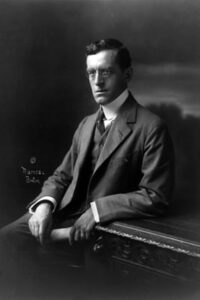
Black Spirits and White
When in May 1886, I found myself at last in Paris, I naturally determined to throw myself on the charity of an old chum of mine, Eugene Marie d’Ardeche, who had forsaken Boston a year or more ago on receiving word of the death of an aunt who had left him such property as she possessed. I fancy this windfall surprised him not a little, for the relations between the aunt and nephew had never been cordial, judging from Eugene’s remarks touching the lady, who was, it seems, a more or less wicked and witch-like old person, with a penchant for black magic, at least such was the common report.
Why she should leave all her property to d’Ardeche, no one could tell, unless it was that she felt his rather hobbledehoy tendencies towards Buddhism and occultism might someday lead him to her unhallowed height of questionable illumination. To be sure d’Ardeche reviled her as a bad old woman, being himself in that state of enthusiastic exaltation which sometimes accompanies a boyish fancy for occultism; but despite his distant and repellent attitude, Mlle. Blaye de Tartas made him her sole heir, to the violent wrath of a questionable old party known to infamy as the Sar Torrevieja, the “King of the Sorcerers.” This malevolent old portent, whose gray and crafty face was often seen in the Rue M. le Prince during the life of Mlle. de Tartas had, it seems, fully expected to enjoy her small wealth after her death; and when it appeared that she had left him only the contents of the gloomy old house in the Quartier Latin, giving the house itself and all else of which she died possessed to her nephew in America, the Sar proceeded to remove everything from the place, and then to curse it elaborately and comprehensively, together with all those who should ever dwell therein.
Whereupon he disappeared.
This final episode was the last word I received from Eugene, but I knew the number of the house, 252 Rue M. le Prince. So, after a day or two given to a first cursory survey of Paris, I started across the Seine to find Eugene and compel him to do the honors of the city.
Everyone who knows the Latin Quarter knows the Rue M. le Prince, running up the hill towards the Garden of the Luxembourg. It is full of queer houses and odd corners,—or was in ’86,—and certainly No. 252 was, when I found it, quite as queer as any. It was nothing but a doorway, a black arch of old stone between and under two new houses painted yellow. The effect of this bit of seventeenth-century masonry, with its dirty old doors and rusty broken lantern sticking gaunt and grim out over the narrow sidewalk, was, in its frame of fresh plaster, sinister in the extreme.
Read or download Book
Ralph Adams Cram
Ralph Adams Cram (December 16, 1863 – September 22, 1942) was a prolific and influential American architect of collegiate and ecclesiastical buildings, often in the Gothic Revival style. Cram & Ferguson and Cram, Goodhue & Ferguson are partnerships in which he worked. Cram was a fellow of the American Institute of Architects.
Early life
Cram was born on December 16, 1863, at Hampton Falls, New Hampshire, to William Augustine and Sarah Elizabeth Cram. He was educated at Augusta, Hampton Falls, Westford Academy, which he entered in 1875, and Phillips Exeter Academy. He was a cousin of Ralph Warren Cram.
At age 18, Cram moved to Boston in 1881 and worked for five years in the architectural office of Rotch & Tilden, after which he left for Rome to study classical architecture. From 1885 to 1887, he was an art critic for the Boston Transcript. During an 1887 Christmas Eve mass in Rome, he had a dramatic conversion experience. For the rest of his life, he practiced as a fervent Anglo-Catholic who identified as high-church Anglican. In the 1890s, Cram was a key figure in “social-controversial-inspirational” groups including the Pewter Mugs and the Visionists.
In 1900, Cram married Elizabeth Carrington Read in New Bedford, Massachusetts. She was the daughter of Clement Carrington Read and his wife. Read had served as a captain in the Confederate Army during the American Civil War. Elizabeth and Ralph had three children, Mary Carrington Cram, Ralph Wentworth Cram, and Elizabeth Strudwick Cram. The family burial site is at the St. Elizabeth’s Memorial Churchyard.[6] The churchyard is adjacent to St Elizabeth’s Chapel, which Cram designed.






